Best Stretches To Do Before An Upper Body Workout
Looking to improve your overhead strength? It’s important to make sure you’ve properly warmed up before completing resistance training to reduce the risk of injury and increase performance!
Here are some of our top movements to get those muscles prepped before your session.
Give these a go before your next upper body workout and let us know how those shoulders feel!
Why is it important to make sure your shoulders are warmed up before lifting weights?
Warming up before any workout is crucial for preparing your body for physical activity and minimising the risk of injury. When it comes to weightlifting, specifically, ensuring that your shoulders are properly warmed up is important.
Reasons why warming up your shoulders before lifting weights is essential:
- Injury Prevention
- Improved Range of Motion
- Activation of Stabiliser Muscles
- Enhanced Performance
- Mental Preparation
Foam Roller Upper Back Release Stretch
The foam roller upper back release exercise is a simple yet effective technique to relieve tension and tightness in the upper back and improve overall posture. By using a foam roller, you can target the muscles in this area, promoting relaxation and reducing discomfort.
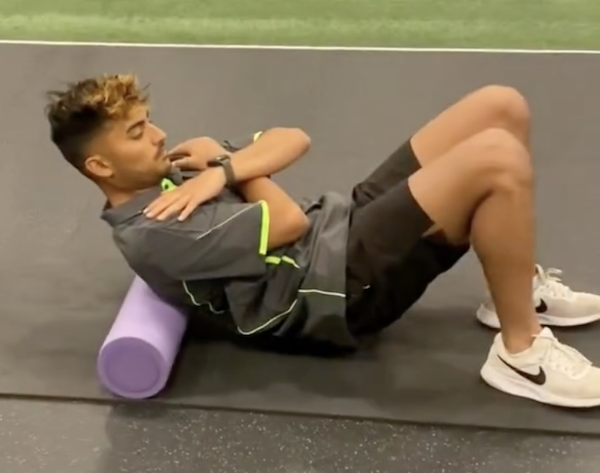
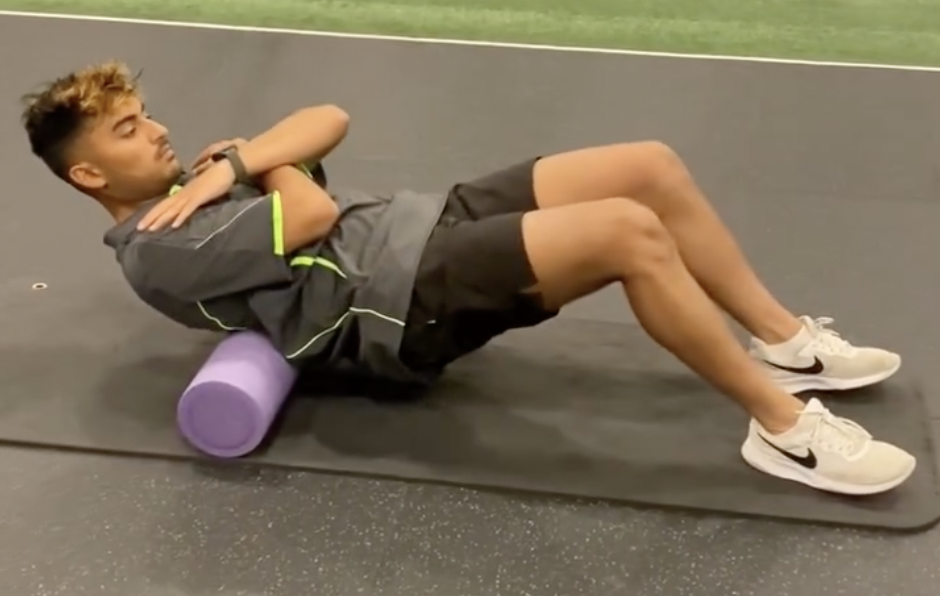
- Begin by placing the foam roller on the ground horizontally.
- Sit in front of the foam roller and position it at the level of your upper back, just below the shoulder blades.
- Bend your knees and place your feet flat on the floor for stability.
- Carefully lie back onto the foam roller, allowing it to support your upper back.
- Position your hands crossed over your chest,
- Slowly roll your body up and down, moving along the length of the foam roller.
- Focus on targeting the muscles between your shoulder blades and along the sides of your spine.
- Pause when you find a point of tension or tightness in a specific area.
Lat Active Stretch
The lat active stretch is a dynamic movement that targets the latissimus dorsi muscles, commonly known as the “lats.” By incorporating a power band, you can enhance the stretch and engage the lats more effectively.
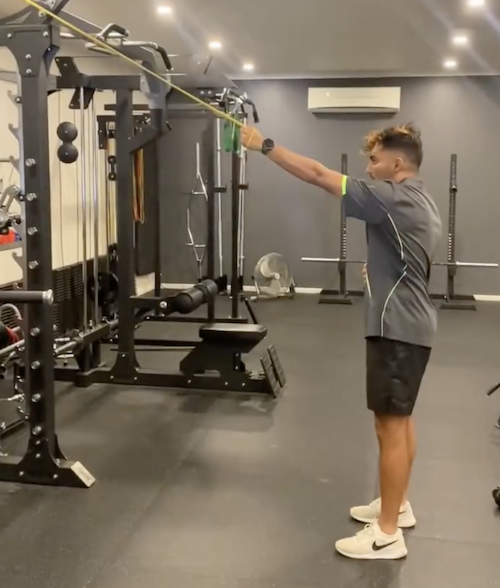

- Begin by securing the power band to a sturdy anchor point such as a pull-up bar or a doorframe at chest height.
- Stand facing the anchor point with your feet shoulder-width apart.
- Hold the power band with an overhand grip, hands positioned slightly wider than shoulder-width apart.
- Step back until you feel tension in the power band, creating resistance.
- Position your body at an angle, leaning forward slightly from the hips.
- Ensure your arms are fully extended, and your shoulders are relaxed.
- Initiate the movement by engaging your lat muscles.
- Squeeze your shoulder blades together as you pull your elbows down and back, aiming to bring them towards your hips.
- Focus on contracting the lats throughout the movement.
- Slowly release the tension in the power band and return to the starting position.
- Keep control throughout the movement, ensuring a smooth and controlled motion.
SINGLE Arm Lat PULL down
The lat active stretch is a dynamic movement that targets the latissimus dorsi muscles, commonly known as the “lats.” By incorporating a power band, you can enhance the stretch and engage the lats more effectively.
Shoulder external rotation
The shoulder external rotation stretch is an effective exercise for improving shoulder mobility and flexibility. By incorporating a power band, you can add resistance to the exercise, enhancing the stretch and strengthening the muscles involved in external rotation.
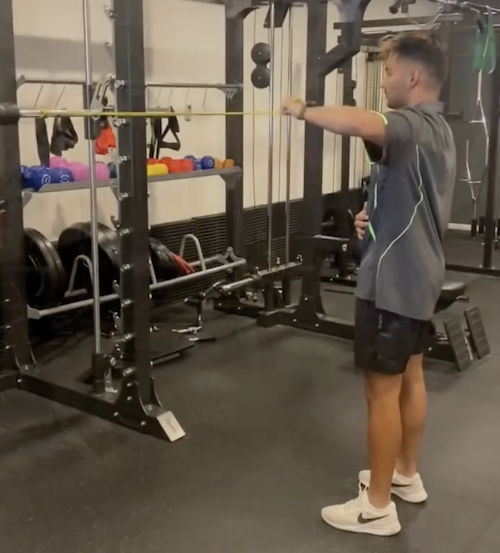

- Stand facing the band with your feet shoulder-width apart.
- Hold the power band with your hand.
- Position your elbow bent at a 90-degree angle and tucked against your side, forming an “L” shape with your arm.
- Stand tall and maintain good posture throughout the exercise.
- Initiate the movement by externally rotating your shoulder, turning your forearm away from your body.
- As you rotate, focus on feeling the stretch in the back of your shoulder.
- Ensure that you maintain control and do not allow momentum to take over.
- Aim for 10-15 repetitions per set, or adjust based on your fitness level and goals.
- Perform 2-3 sets of the shoulder external rotation stretch with the power band.
Resisted shoulder flexion
The resisted shoulder flexion exercise with a resistance band is a beneficial exercise for strengthening the muscles involved in shoulder flexion while improving overall shoulder stability and mobility. By incorporating a resistance band, you can add resistance to the movement, making it more challenging and effective.
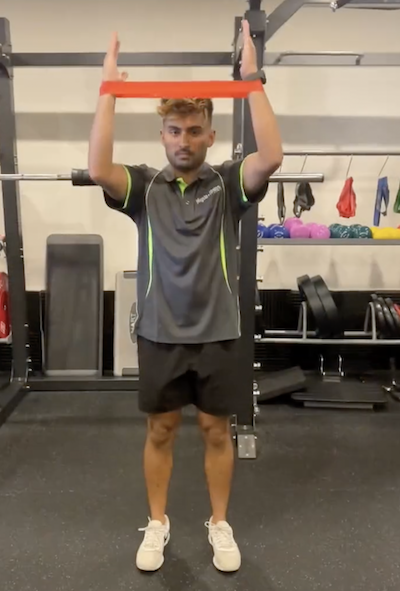
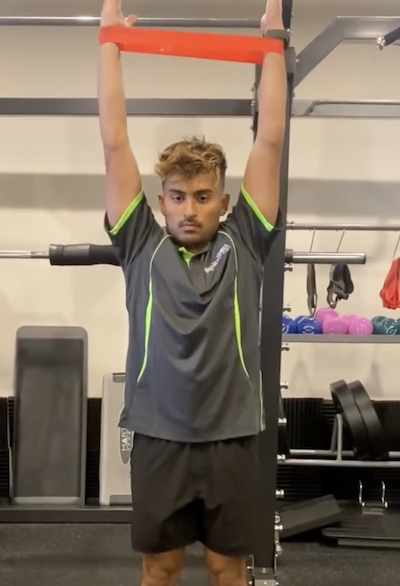
- Begin by selecting a resistance band suitable for your fitness level. Choose a band with enough tension to challenge you but still allows for proper form and control.
- Stand with your feet shoulder-width apart, maintaining good posture and engaging your core muscles.
- Position the resistance band over your wrists, ensuring that it sits snugly and securely.
- Hands facing inwards towards each other.
- Extend your arms straight up overhead, maintaining a slight bend in your elbows.
- The resistance band should be taut but not overly stretched.
- As you lift, focus on engaging the muscles in the front of your shoulders.
- Continue raising your arms until they are fully extended overhead, aiming to bring them as close to your ears as possible.
- Feel the contraction in the front of your shoulders as you reach the top of the movement.
- Slowly and with control, lower your arms back down to the starting position, resisting against the tension of the band.
- Maintain control throughout the movement, focusing on engaging your shoulder muscles.
- Aim for 10-15 repetitions per set, or adjust based on your fitness level and goals.
- Perform 2-3 sets of the resisted shoulder flexion exercise with the resistance band.
The equipment Henry is using in these stretches
In these stretches, Henry incorporates the power band, foam roller, and resistance band in his training. Let’s take a closer look at each piece of equipment:
Power Band: The power band, also known as a resistance band or exercise band, is a versatile tool that adds resistance to various exercises. It consists of a looped or long band made of elastic material. Henry incorporates the power band into his workouts to provide additional resistance and challenge his muscles further.
Resistance Band: Similar to the power band, Henry also includes a resistance band in his workouts. This versatile elastic band provides adjustable resistance to strengthen and tone various muscle groups. With the resistance band, Henry can perform exercises that target his upper body.
Foam Roller: The foam roller is a cylindrical tool made of dense foam that is widely used for self-myofascial release (SMR). Henry incorporates the foam roller into his routine to target muscle tightness and improve flexibility. By rolling different areas of his body over the foam roller, he applies pressure to release knots or trigger points within the muscles and fascia. This technique helps alleviate muscle tension, increase blood flow, and enhance recovery. Henry uses the foam roller to roll out his back. Another foam roller exercise you could try is the chest opener.
Remember, it’s important to listen to your body and avoid any excessive pain or discomfort. If you experience sharp or prolonged pain, consult with a healthcare professional before continuing.
Consistency is key. Make these stretches a regular part of your training regimen to reap the maximum benefits. Keep stretching, keep running, and keep thriving!
